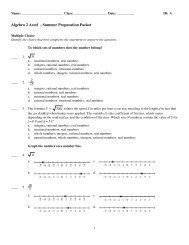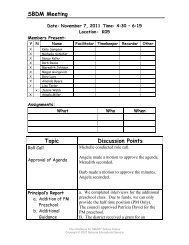1st Grade Pacing Guide - Jessamine County Schools
1st Grade Pacing Guide - Jessamine County Schools
1st Grade Pacing Guide - Jessamine County Schools
- No tags were found...
You also want an ePaper? Increase the reach of your titles
YUMPU automatically turns print PDFs into web optimized ePapers that Google loves.
<strong>Jessamine</strong> <strong>County</strong> <strong>Schools</strong>Recommended <strong>1st</strong> <strong>Grade</strong> <strong>Pacing</strong> <strong>Guide</strong>Reading/LanguageArtsUsing a varietyof literary,informationaland persuasivetexts studentswill:MathWeek 10 Week 11 Week 12 Week 13 Week 14 Week 15 Week 16 Week 17 Week 18Foundational SkillsRF.1.3. Know and apply grade level phonics and word analysis skillsin decoding wordsRF.1.3.c. Know final -e and common vowel team conventions for representinglong vowel sounds.RF.1.3.d. Use knowledge that every syllable must have a vowel soundto determine the number of syllables in a printed word.Reading/Literature (Fiction)RF.1.2 Retell stories, including key details, and demonstrate understandingof their central message or lesson.RF.1.4 Identify words and phrases in stories or poems that suggestfeelings or appeal to the senses.Reading/InformationalRI.1.1 Ask and answer questions about key details in a text.RI.1.2 Identify the main topic and retell key details of a text.RI.1.4 Ask and answer questions to help determine or clarify themeaning of words and phrases in a text.RI.1.5 Know and use various text features (e.g., headings, tables ofcontents, glossaries, electronic menus, icons) to locate key facts orinformation in a text.RI.1.7 Use the illustrations and details in a text to describe its key ideas.NUMBERS AND OPERATIONS IN BASE 10 1.NBTExtend Counting Sequence1.NBT.1 Count to 120, starting at any number less than 100. In thisrange, read and write numerals and represent a number of objectswith a written numeral.Understand place value.1.NBT.2 Understand that the two digits of a two-digit numberrepresent amounts of tens and ones. Understand the following asspecial cases:1.NBT.2 .a 10 can be thought of as a bundle of ten ones — calleda “ten.”1.NBT.2 .b The numbers from 11 to 19 are composed of a ten and one,two, three, four, five, six, seven, eight, or nine ones.1.NBT.2 .c The numbers 10, 20, 30, 40, 50, 60, 70, 80, 90 refer to one,two, three, four, five, six, seven, eight, or nine tens (and 0 ones).Use place value understanding and properties of operationsto add and subtract.1.NBT.4 Add within 20, including adding a two-digit number and aWritingW.1.3 Write narratives in which they recount two or more appropriatelysequenced events, include some details regarding whathappened, use temporal words to signal event order, and providesome sense of closure.Speaking/ListeningSL.1.1.b Build on others’ talk in conversations by responding to thecomments of others through multiple exchanges.SL.1.1.c Ask questions to clear up any confusion about the topics andtexts under discussion.LanguageRF.1.2 Demonstrate understanding of spoken words, syllables, and sounds:RF.1.2.b Orally produce single-syllable words by blending sounds(phonemes), including consonant blends.RF.1.3 Know and apply grade-level phonics and word analysis skillsin decoding words:RF.1.3a. Know the spelling-sound correspondences for commonconsonant digraphs.L.1.1.b Use common, proper, and possessive nounsL.1.1.e Use verbs to convey a sense of past, present, (e.g., YesterdayI walked home; Today I walk home;)one-digit number, and adding a two-digit number and a multipleof 10, using concrete models or drawings and strategies basedon place value, properties of operations, and/or the relationshipbetween addition and subtraction; relate the strategy to a writtenmethod and explain the reasoning used. Understand that in addingtwo-digit numbers, one adds tens and tens, ones and ones; andsometimes it is necessary to compose a ten.OPERATIONS AND ALGEBRAIC THINKING 1.OAAdd and subtract within 20.1.OA.6 Add and subtract within 20, demonstrating fluency for additionand subtraction within 10. Use strategies such as counting on;making ten (e.g., 8 + 6 = 8 + 2 + 4 = 10 + 4 = 14); decomposinga number leading to a ten (e.g., 13 – 4 = 13 – 3 – 1 = 10 – 1= 9); using the relationship between addition and subtraction(e.g., knowing that 8 + 4 = 12, one knows 12 – 8 = 4); and creatingequivalent but easier or known sums (e.g., adding 6 + 7 bycreating the known equivalent 6 + 6 + 1 = 12 + 1 = 13).uL.1.1.f Use frequently occurring adjectivesL.1.1.j Produce complete simple declarative, interrogative, imperative,and exclamatory sentences in response to prompts.L.1.4 Determine or clarify the meaning of unknown and multiplemeaningwords and phrases based on grade 1 reading and content,choosing flexibly from an array of strategies.L.1.4.a. Use sentence-level context as a clue to the meaning of a wordor phrase.L.1.4.c Identify frequently occurring root words (e.g., look) and theirinflectional forms (e.g., looks, looked, looking).Ongoing….After standards are introduced, the skills will continue to be revisitedand teachers should build upon them to reach the depth expectedof the standard to ensure student independence.uRepresent and solve problems involving addition andsubtraction.1.OA.1 Use addition and subtraction within 10 to solve wordproblems involving situations of adding to, taking from, puttingtogether, taking apart, and comparing, with unknowns in all positions,e.g., by using objects, drawings, and equations with a symbolfor the unknown number to represent the problem.Understand and apply properties of operations and therelationship between addition and subtraction.1.OA.3 Apply properties of operations as strategies to add andsubtract.1 Examples: If 8 + 3 = 11 is known, then 3 + 8 = 11is also known. (Commutative property of addition.) To add 2 + 6+ 4, the second two numbers can be added to make a ten, so 2+ 6 + 4 = 2 + 10 = 12. (Associative property of addition.) 1Students do not need to use formal terms for these properties.Add and subtract within 20.1.OA.5 Relate counting to addition and subtraction (e.g., by countingon 2 to add 2).revised August 2010






